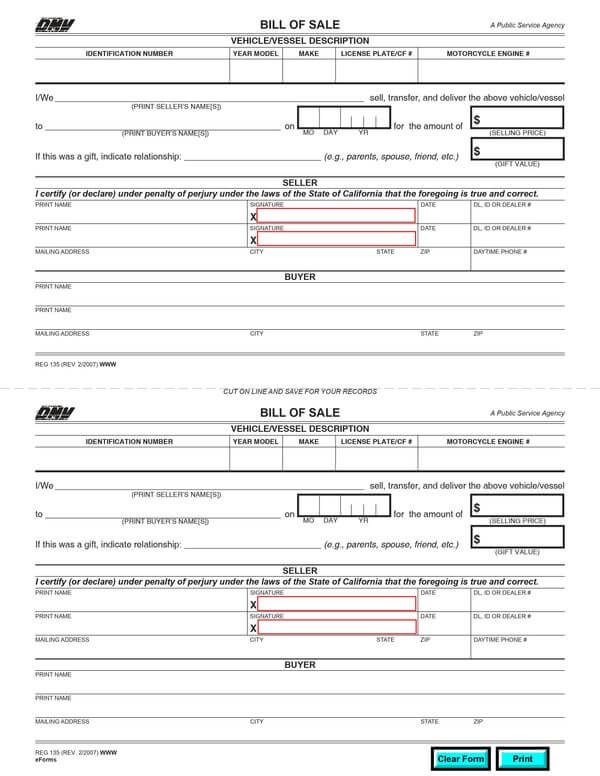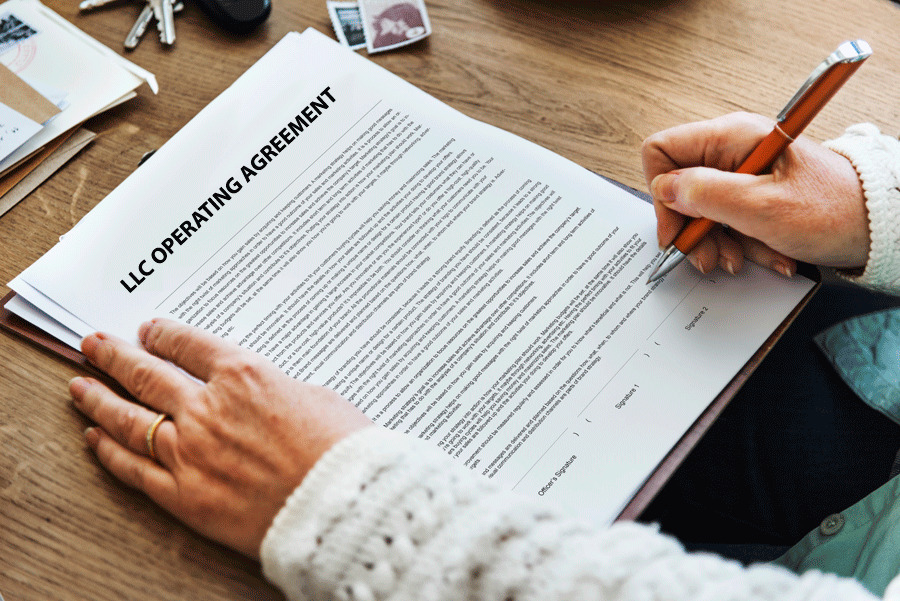In California, when you sell a vehicle, you need to draw up a California bill of sale (REG 135). This document serves as proof of the sale for both the seller and the buyer should a dispute arise.
A REG 135 is also required when transferring ownership of a vehicle and titling it through California’s Department of Motor Vehicles.
A California bill of sale must document the condition that the vehicle is in, both cosmetically and mechanically, the VIN (vehicle identification number), licence plate number, year, make, and model of the vehicle, the purchase price. Also required are the names and contact details for both the seller and buyer. Both the buyer and seller must sign the California bill of sale. The document needs to be written in English, without legal jargon and using clear terms.
If a vehicle has been gifted, the relationship type needs to be included, for example, a parent giving a vehicle to their child as a gift.
Upon purchasing a vehicle, the buyer has 30 days from the date of the sale to register the title with the California DMV. Getting through the process of registering the vehicle can go faster if you make an appointment.
The seller also needs to provide an odometer reading, referred to as a Statement of Facts (REG 256 form), as well as include their driver’s licence number, state ID number, or, for dealerships, the dealer number.
A California Bill of Sale:
- Does not need to be notarized
- Is not required when a vehicle is being sold between properly licensed California dealers
- Is not Required when a dealer sells to a retail buyer, as long as the title of the vehicle has been properly endorsed
- Can be accepted, in place of the release signature or the registered owner. You must print B/S on the release line for the registered owner
- Can be accepted, in place of a buyer’s in-between signature, on the vehicle’s title as long as the in-between buyer’s name is printed on the title
Bill of Sale Form

What is the Benefit of a California Bill of Sale?
For the seller, the California bill of sale REG 135 form is a receipt or proof that the sale took place and it will free the seller from liability should anything happen to the vehicle after it has been sold.
For the buyer, a California bill of sale REG 135 form will clearly document what the vehicle’s condition is at the time of the sale. Should there be damages to the vehicle that the seller did not list, the REG 135 acts as proof of the sale and prove the liability on the seller.
For both parties, a California bill of sale acts as proof that the sale took place and the vehicle sold was in a certain condition, this way neither party can claim that it did not.
Registering a Vehicle
In order to register a vehicle properly, there are a few essential steps that require to be taken in a specific order and manner.
Following are the steps for registering a vehicle:
Consider time period
- New owners: If you are a new vehicle owner who has purchased a used or new vehicle through a private sale, you are required to register the vehicle within a 10 day period from the date of purchase.
- New residents: If you are a new resident to California who is transferring your vehicle from a different state, you must register your vehicle within a 20 day period of the date that your California residency has been established.
Registrations and renewals
Vehicle registration requires yearly renewal, which must be done upon the expiration date. You can request a vehicle renewal in person at your nearest California DMV field office or through California’s DMV’s online portal.
You may also mail in your documentation to the DMV:
Vehicle Registration Operations
Department of Motor Vehicles
PO Box 942869
Sacramento, CA 94269-0001
Documents Required for Registration
It is best to make an appointment with the California DMV to register a vehicle.
You will need to bring the following:
- A completed California Bill of Sale (Form REG 135)
- A completed Statement of Facts (Form REG 256)
- A signed Certificate of Title. If you have damaged or lost this document, you will need an Application for Duplicate or Transfer Title)
- Application for Title or Registration (Form REG 343)
- A valid California driver’s license
- A completed Smog and Emissions Inspection, which must be done at an accredited station
- A Release of Liability (Form REG 138). The seller must send this within 5 days from the date of sale.
- The appropriate Registration Fees
- Proof of vehicle insurance, which must have the Minimum Requirements:
- $15,000 of cover for injury/death of one person
- $30,000 of cover for injury/death of more than one person
- $5,000 of cover for property damage
- If you are registering the vehicle on behalf of someone else, you will need a Motor Vehicle Power of Attorney (Form REG 260)
Rules for Registering Salvaged Vehicles
Before a previously classed junk or salvage vehicle can be registered for use on the highway, it must be inspected by an employee of the DMV who is authorized to do so, or it needs to be referred to and inspected by the California Highway Patrol. If the vehicle passes inspection, you will be given a Certificate of Inspection (Form CHP 97C) by the California Highway Patrol to submit to the DMV for registration of the vehicle.
In some cases, the CHP may complete an Application for Assigned VIN Plate (Form REG 124), or a Verification of Vehicle (Form REG 31), in place of a CHP 97C form.
Conclusion
In order to make a vehicle sale in California, a California bill of sale is essential as it records and proves that the particular sale was made from a seller to a buyer and the condition in which the vehicle sold or bought was; at the time of the sale. It protects both the buyer and the seller from future liability and formalises as well as secures the deal.












